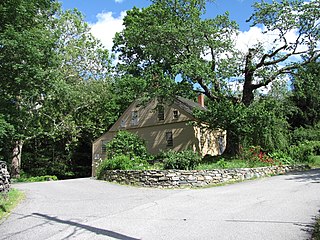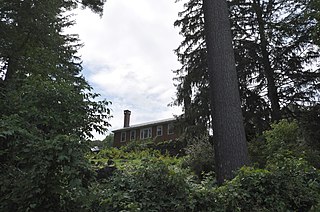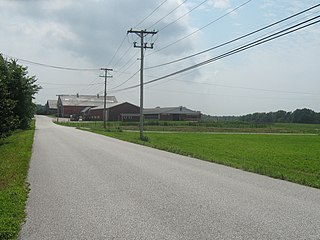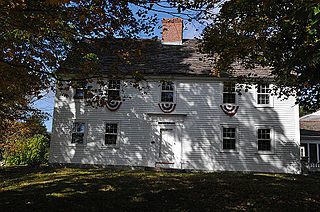
The Spencer–Peirce–Little Farm is a Colonial American farm located at 5 Little's Lane, Newbury, Massachusetts, United States, in the midst of 231 acres (93 ha) of open land bordering the Merrimack River and Plum Island Sound. The farmhouse, dating to c. 1690, was designated a National Historic Landmark in 1968 as an extremely rare 17th-century stone house in New England. It is now a nonprofit museum owned and operated by Historic New England and open to the public several days a week during the warmer months; an admission fee is charged for non Members.

The Shuart-Van Orden Stone House is located on Allhusen Road in Plattekill, New York, United States, near the Thaddeus Hait Farm. The original stone house was built in 1740. It was added to the National Register of Historic Places in 1995, as a highly stylized version of a typical Hudson Valley Dutch Colonial house, the use of brick and gambrel roof in its construction reflecting the influence of migrants from New Jersey and New York City, where that was more common.

The Wheeler-Merriam House is a historic house located at 477 Virginia Road in Concord, Massachusetts. With a construction history dating to about 1692, it is one of Concord's oldest buildings. It is also notable for having joinery by Abner Wheeler, a prominent local builder of the late 18th century, and for its long association with the locally prominent Wheeler and Merriam families. It was added to the National Register of Historic Places on November 26, 1982.

Paddock Farm is a historic farmstead at 259 Salisbury Street in Holden, Massachusetts, United States. The main house, built c. 1840 and attached to a c. 1780 earlier house, is a well-preserved example of a local variant of a Cape style house. It is built with a knee-walled second story, with short windows set below the eave. The farmstead was listed on the National Register of Historic Places in 1996.

Stony Farm is a historic farmstead in Holden, Massachusetts. Built about 1790, the main house is a well-preserved local example of Federal architecture, and the surviving elements of the one-extensive farm property are a reminder of Holden's predominantly agrarian past. The house was listed on the National Register of Historic Places in 1995.

The Freegrace Marble Farm Historic District encompasses a historic farmstead in Sutton, Massachusetts. Although most of its buildings date to the 19th century, the farm has retained the form of a typical 18th-century farm, including a substantial portion of the land granted in 1717 to Freegrace Marble, one of Sutton's earliest colonial settlers. The property was listed on the National Register of Historic Places in 1989.

The Stanley Lake House is a historic First Period house in Topsfield, Massachusetts. It is a 2+1⁄2-story wood-frame house that was built in stages by Mathew Stanley or his heirs between c. 1675 and 1693 and subsequently enlarged by the Lake family. It illustrates a host of building practices over the 17th and 18th centuries. The first Matthew Stanley house was said by Dow to be located northwest of this building. The first portion of this building is the section from the chimney westward. An easterly room was added after and a further addition to the east by the Lakes c. 1750. Matthew Stanley's heirs having removed to the Attleborough Falls area, sold the 70 acre farm property 1710- 1718 to Eleazer Lake. The property also includes a rare First Period barn. It was listed on the National Register of Historic Places in 1990. In 2005 it was named a contributing property to the River Road-Cross Street Historic District.

The Daniel Morse III House is a historic First Period house at 210 Farm Road in Sherborn, Massachusetts. With its oldest portion dating to about 1710, it is one of the town's oldest surviving buildings. It was listed on the National Register of Historic Places in 1986.

The Stone Jug is a historic house at the corner of NY 9G and Jug Road in Clermont, New York, United States. It dates to the mid-18th century and is largely intact, although it has been expanded somewhat since then.

The Parker–Hutchinson Farm is a historic farm property on Parker Bridge Road in Coventry, Connecticut. It includes the Samuel Parker House which dates from 1850. The significance of the property is not for the architecture of its farmhouse, but rather as a remarkably intact site where a number of small-scale industrial enterprises were conducted. The property was listed on the National Register of Historic Places in 1982.

The Brown-Davis-Frost Farm, now called Lantern House Farm, is a historic farm property at 17 Whitney Street in Jefferson, a village of Holden, Massachusetts. It has a history dating to the 18th century, and includes one Holden's oldest brick houses. The property was listed on the National Register of Historic Places in 1995.

The Dimond Hill Farm is a historic farm at 314 Hopkinton Road in the western rural section of Concord, New Hampshire. Established on land that was first farmed by Ezekiel Dimond in the mid-18th century, this area has been farmed by the members of the Abbott-Presby family since 1827, and is one of the few remaining working farms in the city. The main house is an 1892 rambling structure that connects the family living space with the large barn, which dates to c. 1882. The oldest structure on the farm is a corn crib from the 1850s. The farm was listed on the National Register of Historic Places in 2007. The owners operate a farm stand on a seasonal basis.

The Hosford–Sherman Farm is a historic farm property on Vermont Route 30 in northern Poultney, Vermont. Established in the late 18th century, the farm includes the original farmhouse, now an ell to a 19th-century brick house, and a late 19th-century barn, along with more than 120 acres (49 ha) of farmland. The property was listed on the National Register of Historic Places in 1995.

The King Farm is a historic farm property at King Farm Road in Woodstock, Vermont. Encompassing more than 150 acres (61 ha) of woodlands and pasture, the farm has 150 years of architectural history, include a rare 18th-century English barn. Originally a subsistence farm, it became a gentleman's farm in the late 19th century, and its farmstead now hosts a regional government commission. The farm was listed on the National Register of Historic Places in 1997.

The Owen Moon Farm is a historic country estate on Morgan Hill Road in South Woodstock, Vermont. Set on a steeply sloped 8-acre (3.2 ha) parcel are its main house, an 1816 brick building, a barn, and a 1930s bungaloid guest house. The hilly terrain is heavily landscaped, forming an important visual component of the estate, and serving to afford it privacy from the nearby public roads. It was listed on the National Register of Historic Places in 1983, primarily for the well-preserved Federal period architecture of the main house.

The Aaron Jr. and Susan Parker Farm is a historic farm property at 1715 Brook Road in Cavendish, Vermont. Now just 16 acres (6.5 ha), the property includes a c. 1815 Federal style farmhouse, and a well-preserved early 19th century English barn. The farmstead was listed on the National Register of Historic Places in 2014.
Fenn Farm is a historic property on Case Street in Middlebury, Vermont. Developed c. 1828 as a sheep farm but now diversified, it now includes a well-preserved collection of mid-19th century farm buildings. It was listed on the National Register of Historic Places in 1995.

The Ballard Farm is a historic farm property on Ballard Road in Georgia, Vermont. At the time of its listing on the National Register of Historic Places in 1993, it had been under cultivation by members of the Ballard family for more than 200 years, having been established in 1788 by a sale from Ira Allen to Joseph Ballard.

The Capt. Thomas Fanning Farmstead is a historic farm property at 1004 Shewville Road in Ledyard, Connecticut. With a building history dating to about 1746, it is one of the oldest surviving agricultural properties in the town, including the house, barn, and smaller outbuildings. The property, now reduced to 4 acres (1.6 ha), was listed on the National Register of Historic Places in 1992.

The Lamb Homestead is a historic farm property at 47 Lambtown Road in Ledyard, Connecticut. Developed since the early 18th century, it is one of the town's oldest farms, with a long association with the Lamb family, early settlers and important in the development of the Lambtown area of the community. The property was listed on the National Register of Historic Places in 1991.






















